POLS 1140
Ideology and Issues
Updated Mar 9, 2025
Wednesday
Plan for the Week
Wednesday
- Finish up Converse (1964)
- Begin:
- Survey groups assigned (will update today)
Friday
- No class
- I’ll record some comments on material we haven’t covered
Groups
Review
- Election forecasting is both art and science
- Hard to predict direction of polling errors
- Models are complicated / transparency is key
- Converse (1964)
- Explore the degree of ideological constraint in the American public
Using polls to forecast elections
Forecasting Elections
Election forecasts reflect varying combinations of:
- Expert Opinion
- Fundamentals
- Polling
Forecasts differ in the extent to which they rely on these components and how they integrate them in their final predictions
FiveThirtyEight’s Approach to Forecasting
Under Nate Silver…

Forecasting Elections with Polls
The preeminence of polling in modern forecasts reflects the success of Nate Silver and FiveThirtyEight in correctly predicting the 2008 (49/50 states correct) 2012 (50/50) presidential elections
Any one poll is likely to deviate from the true outcome
Averaging over multiple polls
the polls aren’t systematically biased
Concerns about the polls reflect the failure of such approaches to predict
Trump’s Victory in 2016
Strength of Trumps Support in 2020
Polling in Recent Elections
Polling the 2016 Election:
- The polls missed bigly
- National polls were reasonably accurate (Clinton wins Popular Vote)
- State polls overstated Clinton’s lead / understated Trump support
How did we get it so wrong in 2016?

Some likely explanations
Likely voter models overstated Clinton’s support
Large number of undecided voters broke decisively for Trump
White voters without a college degree underrepresented in pre-election surveys
Weighting for education

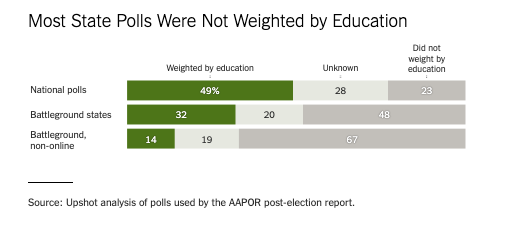
2018: A brief repreive?
Polls did a better job
- Most state polls weighted by education
- Underestimated Democrats in House and Gubernatorial races
- No partisan bias in Senate Races
Forecasts correctly call:
- Democratic House
- Republican Senate
However…
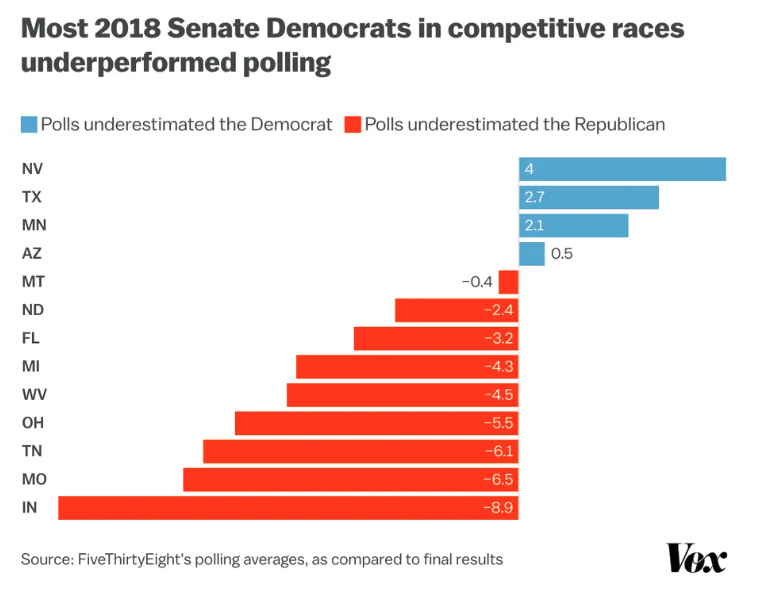
2020: Historic Problems, Unclear Solutions
Average polling errors for national popular vote were 4.5 percentage points highest in 40 years
Polls overstated Biden’s support by 3.9 points national polls (4.3 points in state polls)
Polls overstated Democratic support in Senate and Guberatorial races by about 6 points
Forecasts predicted Democrats would hold
- 48-55 seats in the Senate (actual: 50 seats)
- 225-254 seats in the House (actual: 222 seats)
2020: What Went Wrong
Unlike 2016, no clear cut explanations for what went wrong
Not a cause:
- Undecided voters
- Failing to weight for education
- Other demographic imbalances
- “Shy Trump Voters”
- Polling early vs election day voters
Potential Explanations
- Covid-19
- Democrats more likely to take polls
- Unit non-response
- Between parties
- Within parties
- Across new and unaffiliated voters
How the polls did in 2022
Overall, pretty good
Average error close to 0
Average absolute error ~ 4.5 percentage points
Some polls tended overstate Republican support (e.g. Trafalgar)
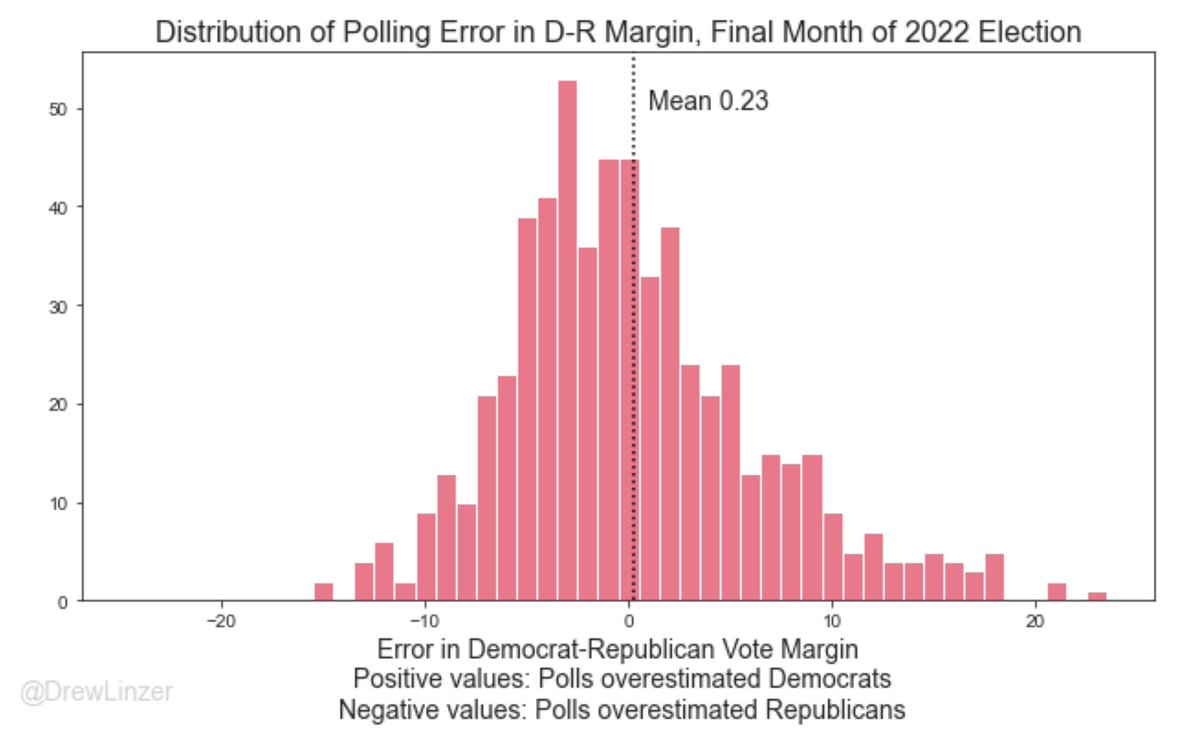
What do the polls say for 2024
Harris 2-3 point lead in popular vote
Math of electoral college favors Republican candidates
Polls will be wrong, but hard to predict the direction of the error (this is a good thing)
A lot can happen
Different:
- Polls
- Weighting of fundamentals and polls
- Different modeling assumptions (How to model convention bumps)
Who’s right?
Converse (1964)
Goals
This weeks readings are HARD
Our goal is to answer the following:
- What’s the research question
- What’s the theoretical framework
- What’s the empirical design
- What’s are the results
- What’s are the conclusions
The Structure of Converse (1964)
- Introduction
- Some Clarification of Terms
- Sources of Constraint on Idea Elements
- Active Use of Ideological Dimensions of Judgement
- Recognition of Ideological Uses of Judgement
- Constraints among idea-elements
- Social Groupings as central objects in belief systems
- The Stability of belief elements over time
- Issue Publics
- Summary
- Conclusion
Introduction
Converse introduces the concept of belief systems and tells us this article is about the contrast between the belief systems held by political elites and the mass public
He gestures towards a hierarchy of belief strata and the importance of belief systems for democratic theory
Kind of slow start
Some Clarification of Terms
Converse defines his core concepts
Beliefs Systems
Idea elements
Constraint:
- The interdependence of ideas in a belief system
- A sense of what goes with what
Centrality:
- How likely a belief is to change?
Range:
- The diversity of topics
Sources of Constraint
(Theoretical Framework)
Converse lays out some plausible sources of ideological constraint:
Logical: More spending + Less taxes -> Bigger deficits
Psychological: “the quasi-logic of cogent arguments”
Social: Social diffusion of information -> creates perceptions of what goes with what
Converse also offers a definition of the well-informed person who understands what goes with what but can also articulate why.
Consequences of declining information belief systems
Converse argues as we move from the well-informed to uninformed, several things happen:
- Belief systems lose constraint
- Social groups replace ideology principles in centrality
So how does he go about doing showing this?
Active Use of Ideological Dimensions of Judgement
Converse considers people’s open-ended responses to questions about whether there is anything they like or dislike about presidential candidates in 1956 and the political parties discussed in detail in chapter 10 of the The American Voter
Active Use of Ideological Dimensions of Judgement
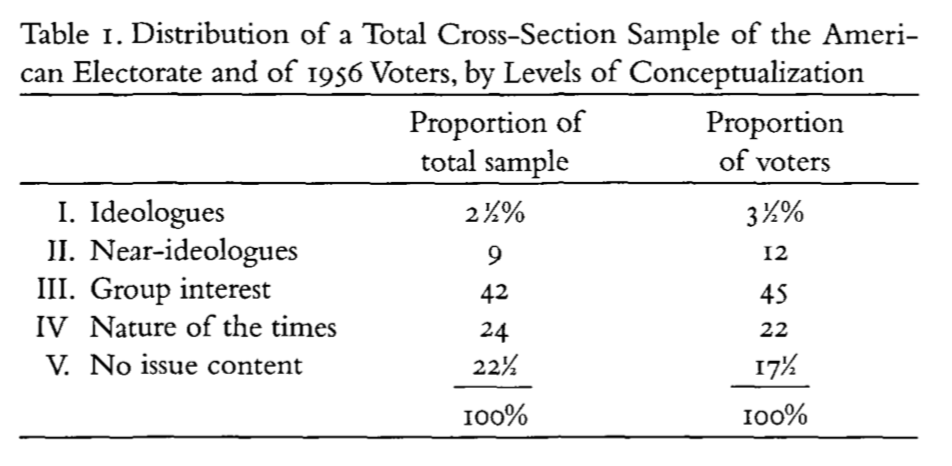
The American Voter
Ideologues:
Well, the Democratic Party tends to favor socialized medicine and I’m being influenced in that because I came from a doctor’s family.
Group Benefits:
Well I just don’t believe their for the common people
Nature of the times:
My husband’s job is better. … My husband is a furrier and when people get money they buy furs
No Content:
I hate the darned backbiting
Recognition of Ideological Dimensions of Judgement
Next Converse considers these levels of conceptualization in 1956 with peoples ability to attach the correct ideological labels with political parties
Overall, most respondents label Democrats as the liberal and Republicans as the conservative party (Table 2)
But the depth of this understanding appears quite shallow (e.g. spend vs save) (Table 3)
Recognition varies with education (Table 4)
Those with greater levels of recognition are more active in politics (Table 5)
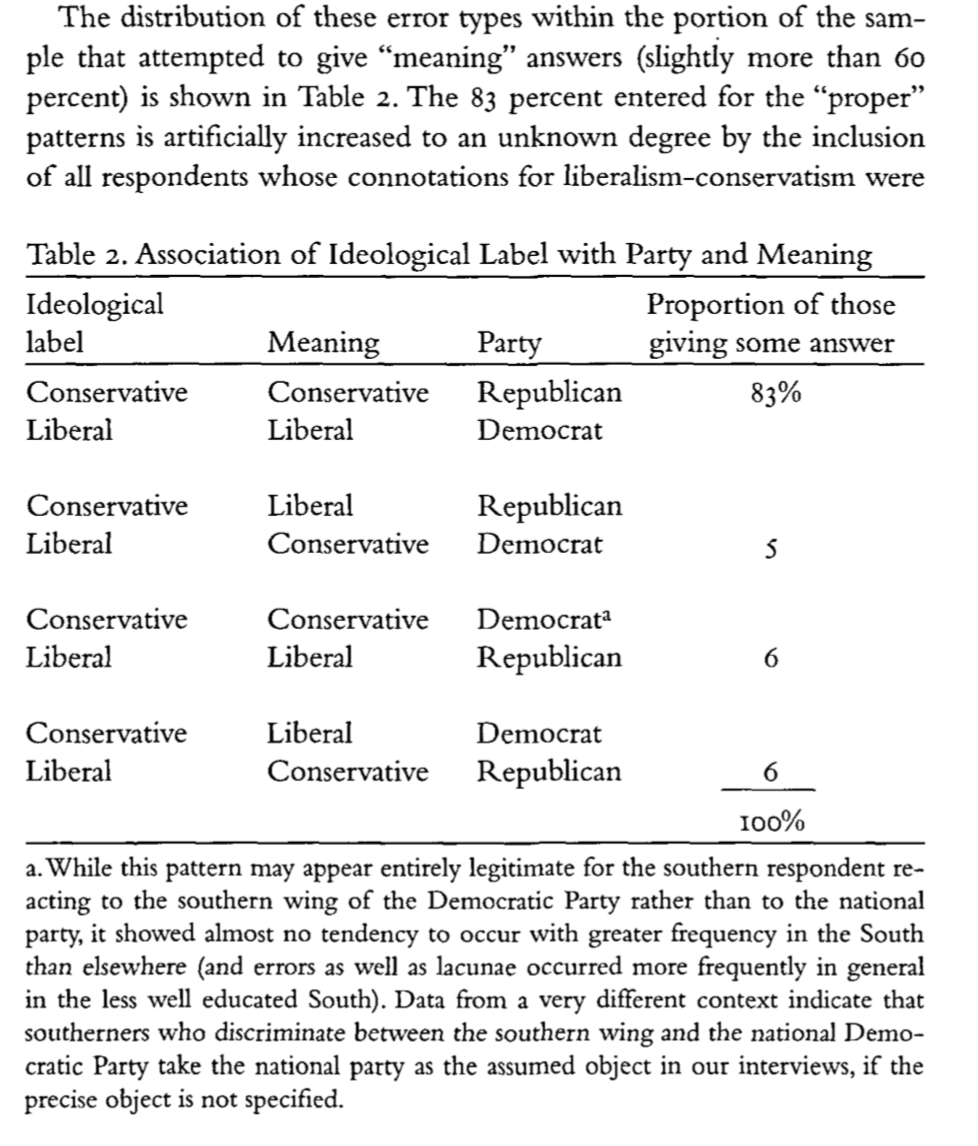
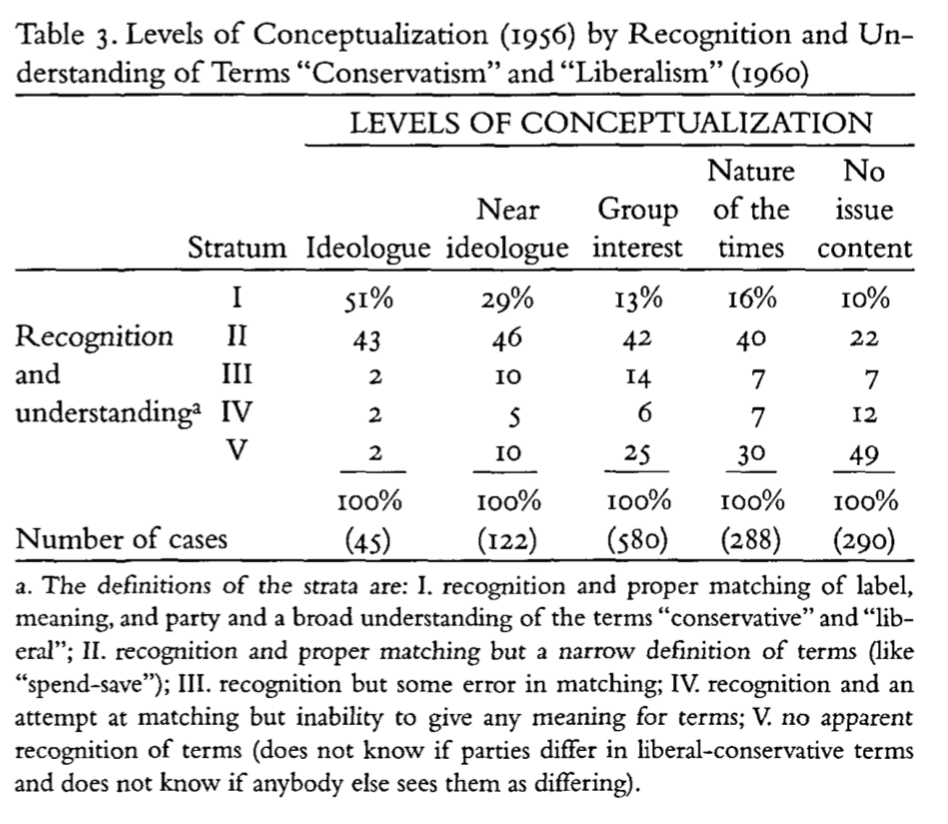
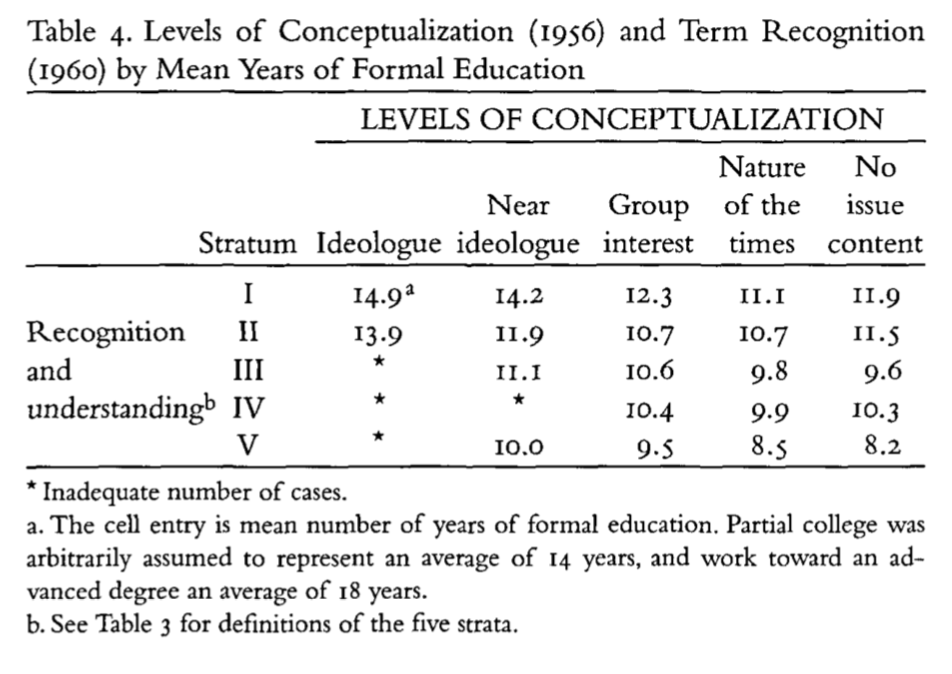
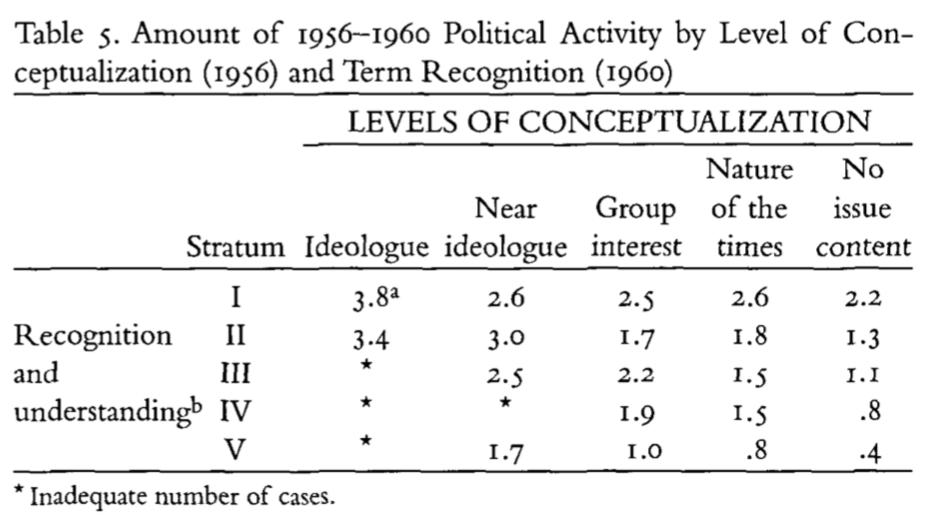
Constraints among idea-elements
Next Converse considers the degree of constraint (measured by correlations) between issue elements in an elite (congressional candidates) compared to the mass public
People who took a liberal position on one issue did not necessarily take a liberal position on another
the correlations between between elites’ issue attitudes were higher than the mass public
Individuals lack a sense of what goes with what
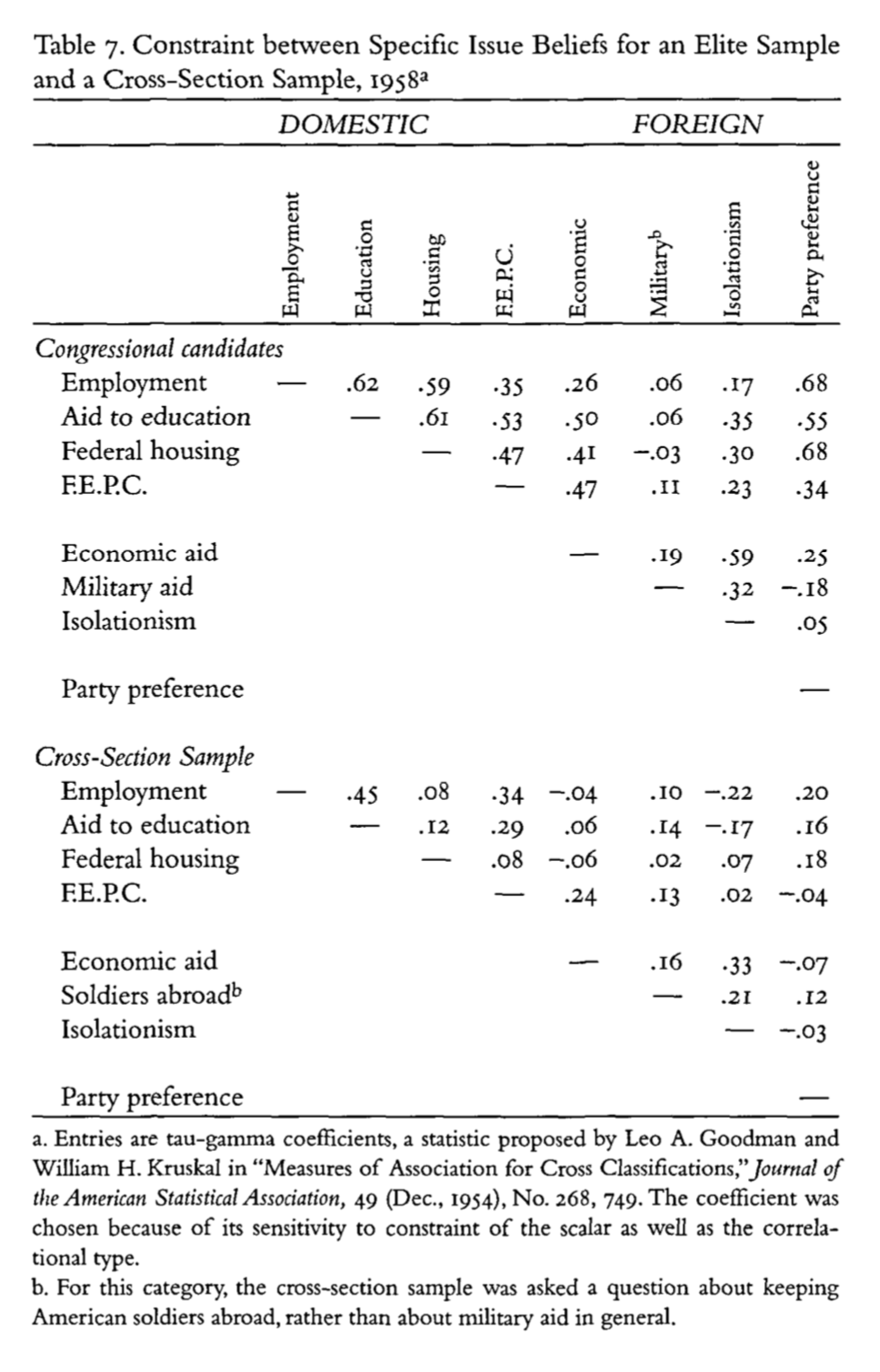
What are these measures
Read the footnotes!

What are these measures
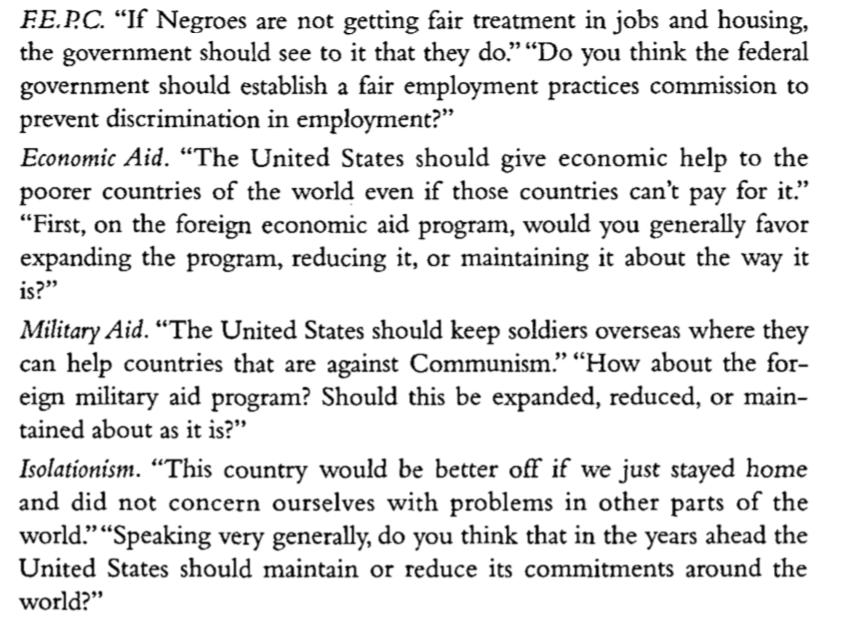
What’s a tau-gamma coefficient?
I believe Converse is using a measure of association for ordinal data that’s built off the cross tabs of variables. The estimate of gamma,
where “ties” (cases where either of the two variables in the pair are equal) are dropped. Then
Note
As long as you have a basic sense of what correlations are trying to tell us you don’t need to know the technical details of a specific estimator
Elites show higher degrees of constraint

Social groupings as central objects in belief systems

The stability of belief elements over time
Converse considers the stability of responses over time, looking at data from 1958-1960 finding variation the strength of temporal correlations across surveys, and attributes this to the centrality of groups and the party system for the mass public
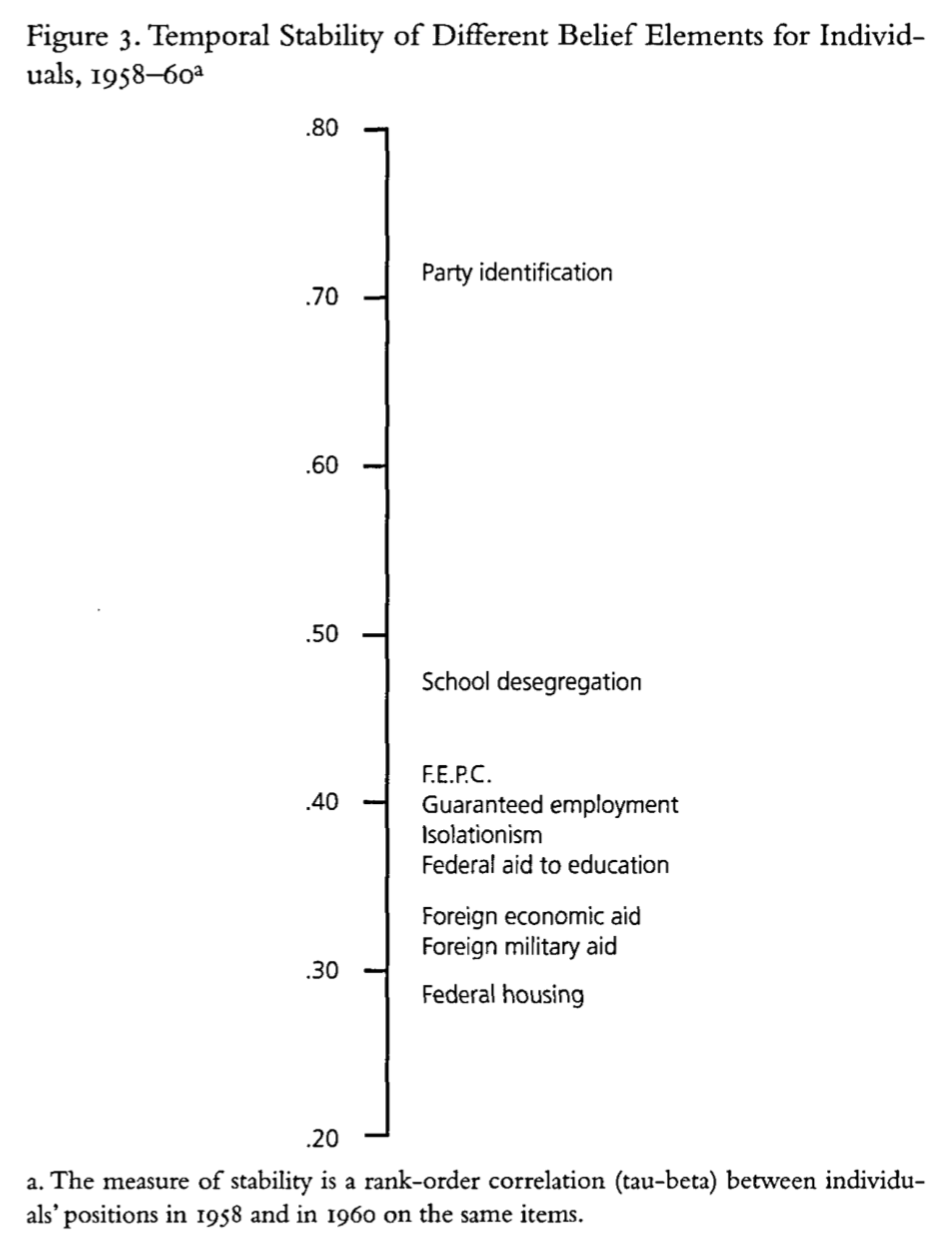
The stability of belief elements over time
The final piece of Converse’s argument concerns the stability of a single belief over time (1956, 1958, 1960):
The government should leave things like electrical power and housing for private businessmen to handle
A limiting case an issue not in the public debate of this period
People appear to answer the question at random
Only a small proportion (~20% fn. 39) held stable attitudes across all three periods
Issue Publics, Summary, Conclusion
Converse wraps up his argument by
Allowing for the possibility of small “issue publics” on more narrow issues
Offering some comments on cross-national and historical comparisons
Summarizing the “continental shelf” that exists between elites and masses.
What do we think?
- What’s the research question
- What’s the theoretical framework
- What’s the empirical design
- What’s are the results
- What’s are the conclusions
Summary of Converse (1964)
Converse (1964) remains one of the most influential articles in American Political Behavior
Framed decades of research on questions of ideology and citizen competence
- Why?
In the absence of coherent and stable worldviews, how does democracy function?
Responses to Converse (1964)

Responses to Converse (1964)
- Measurement error (Today)
- Revised definitions of citizens competence (Next Week)
- The Miracle of Aggregation
- Source Cues and Heuristics (Weeks 5 and 6)
- Revised models of Survey Response (Weeks 5 and 6)
- Revised models of what democracy requires (on going)
The Miracle of Aggregation
Responses to Converse (1964)
- Measurement error (Today)
- Revised definitions of citizens competence (Next Week)
- The Miracle of Aggregation
- Source Cues and Heuristics (Weeks 5 and 6)
- Revised models of Survey Response (Weeks 5 and 6)
- Revised models of what democracy requires (on going)
Class Survey
Please click here to take our periodic attendance survey
Ansolabehere et al. (2008)
What’s the research question
- Are issue preferences as unstable and incoherent as Converse suggests, or can accounting for measurement error reveal a more ideologically consistent mass public
What’s the theoretical framework
Ansolabehere et al. pick up a critique made by Achen (1975) and others that the lack of constraint is primarily caused my measurement error
They show that measurement error tends to decreases with the number of items one uses
They offer a simple solution measure concepts scales constructed from multiple items
Measurement Error
Classic measurement error models assume what we observe is a measure of some unobserved (latent) truth, plus measurement error that has mean 0 and is uncorrelated with the latent truth, X.
Measurement Error
One can show that:
And the covariance between our observed and unobserved variables is:
Correlations and Reliability
With some assumptions and transformations we can show that the square of correlations describe the reliability of a measure
Reliability is the proportion of the variance in the observed variable that comes from the latent variable of interest, and not from random error.
This motivates Ansolabehere et al. approach
Correlations and Reliability
Measurement error reduces reliability

Multiple items reduce measurement error
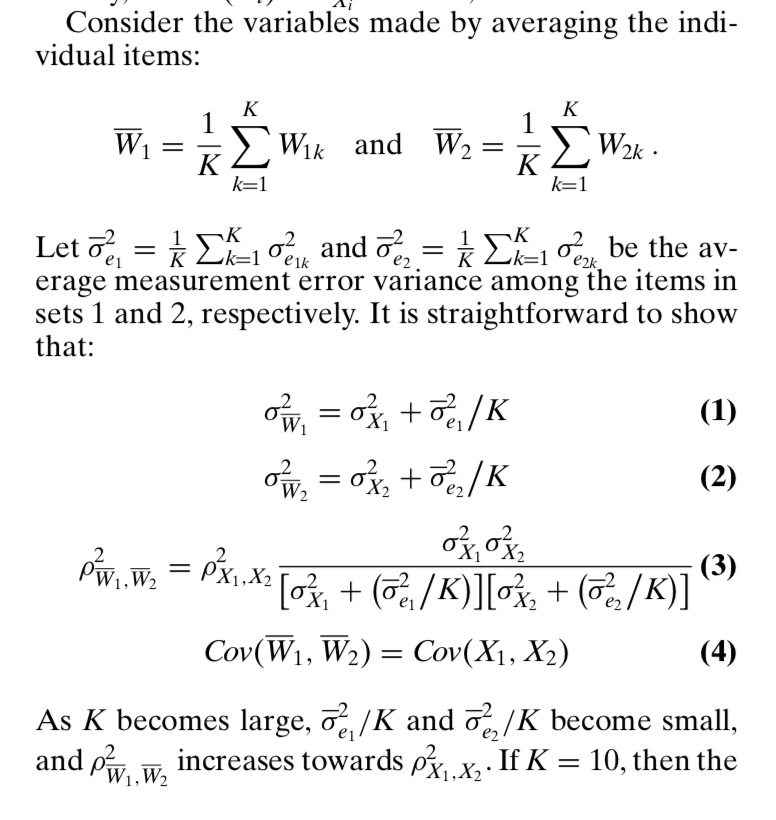
With some caveats
- No autocorrelation
- Error on one item doesn’t predict error on another
- Additional items can’t be too noisy

What’s the empirical design
Panel data from the NES
Principal component factor analysis to scale items together
- Basically averaging (weighting by the variance each item contributes)
Correlational analysis within items and across time and also within surveys
Simulations
Sub-group analysis by political sophistication
Regression analysis of issue voting
Principal Components Analysis
Find dimensions that explain the maximum variance with the minimum error
A useful tool for data reduction
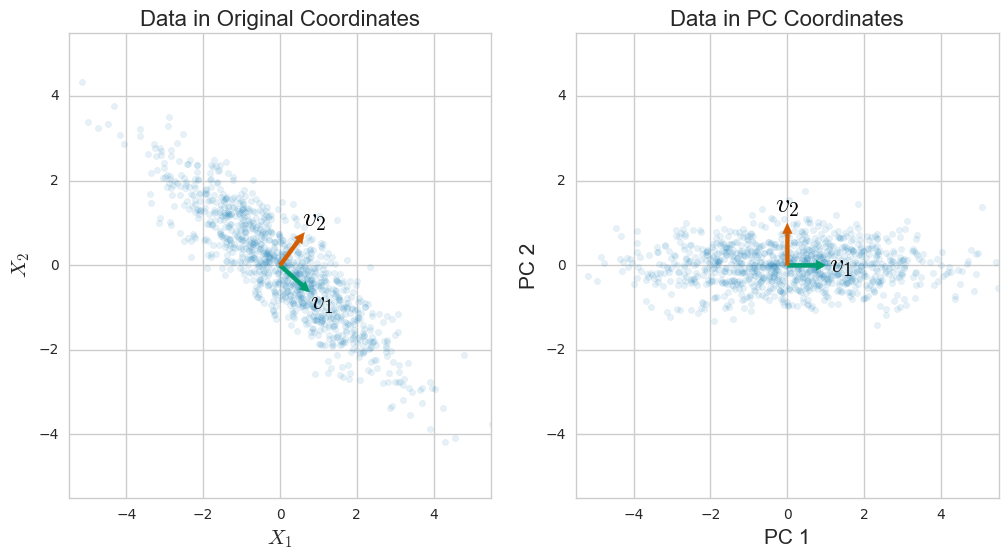
What’s are the results
- The over time reliability of of scales increases with the number of items used
- Table 1, Figure 1
- Table 1, Figure 1
- The correlations are higher between scales within surveys
- Table 2, Figure 2
- Issue scales are more stable than policy predispositions
- Table 3
- Little variation across political sophistication
- Table 4
- Issue scales predict vote choice
- Table 5
The over time reliability of of scales increases with the number of items used

The over time reliability of of scales increases with the number of items used

The correlations are higher between scales within surveys

Issue scales are more stable than policy predispositions
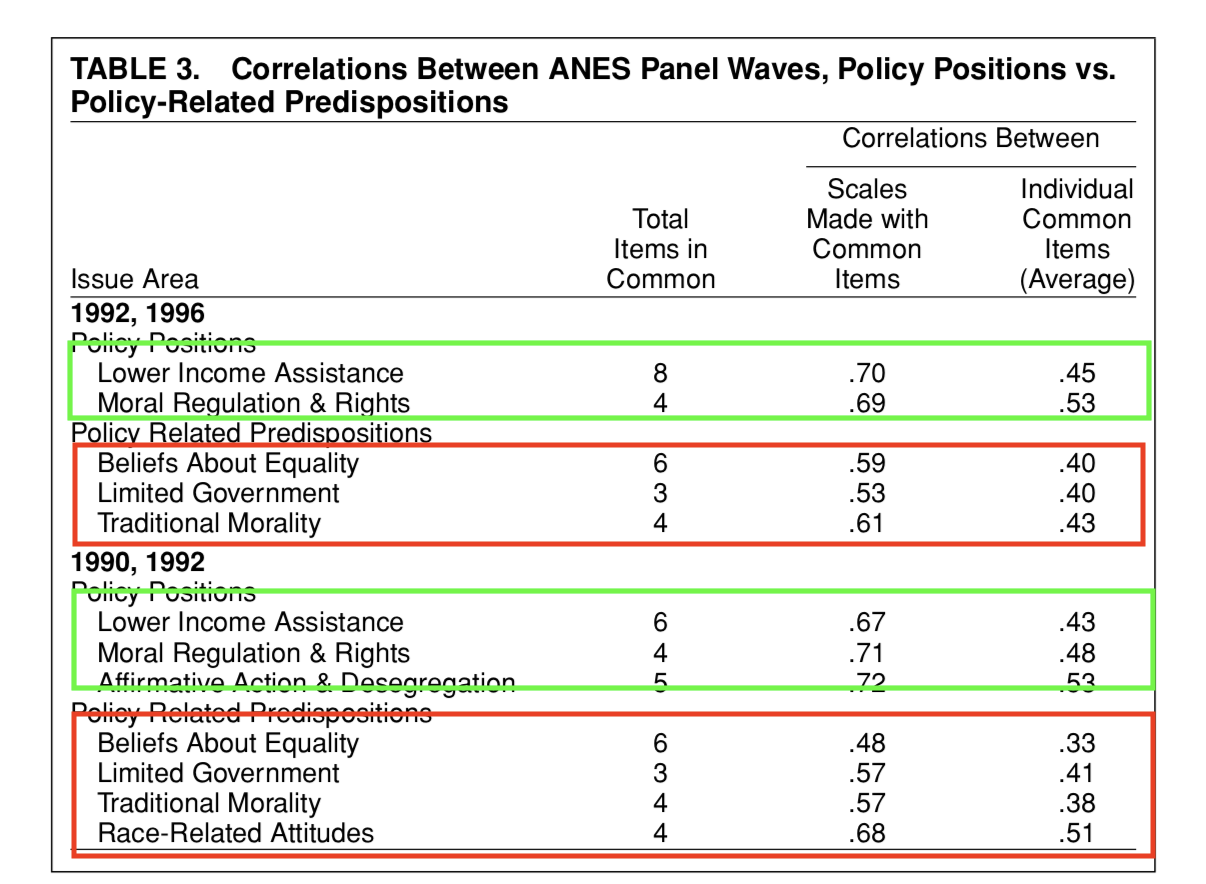
Little variation across political sophistication
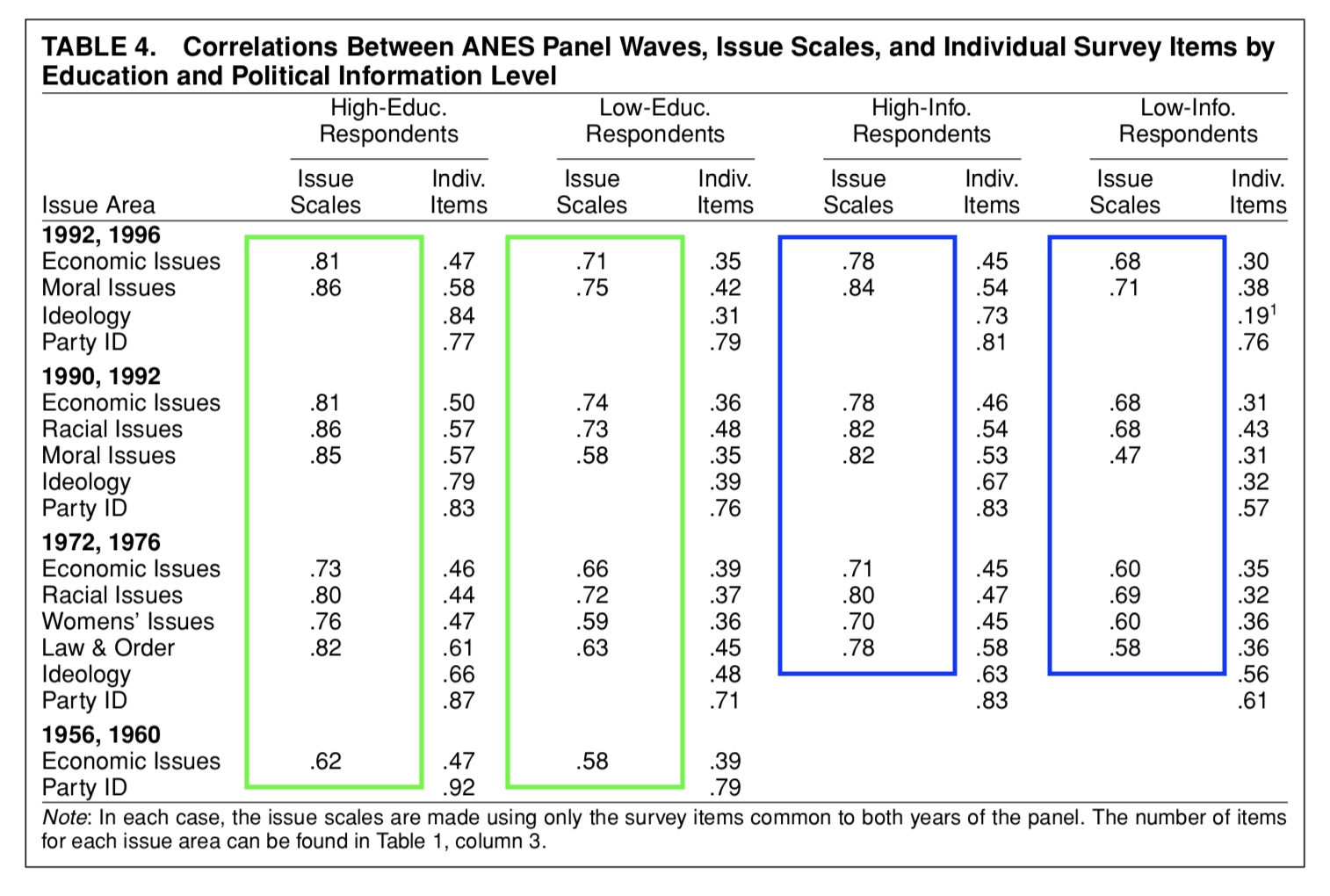
This is in contrast to what Converse’s “Black and White” model would predict and consistent with general arguments about measurement error
The entry point for Freeder et al.’s critique
Issue scales predict vote choice
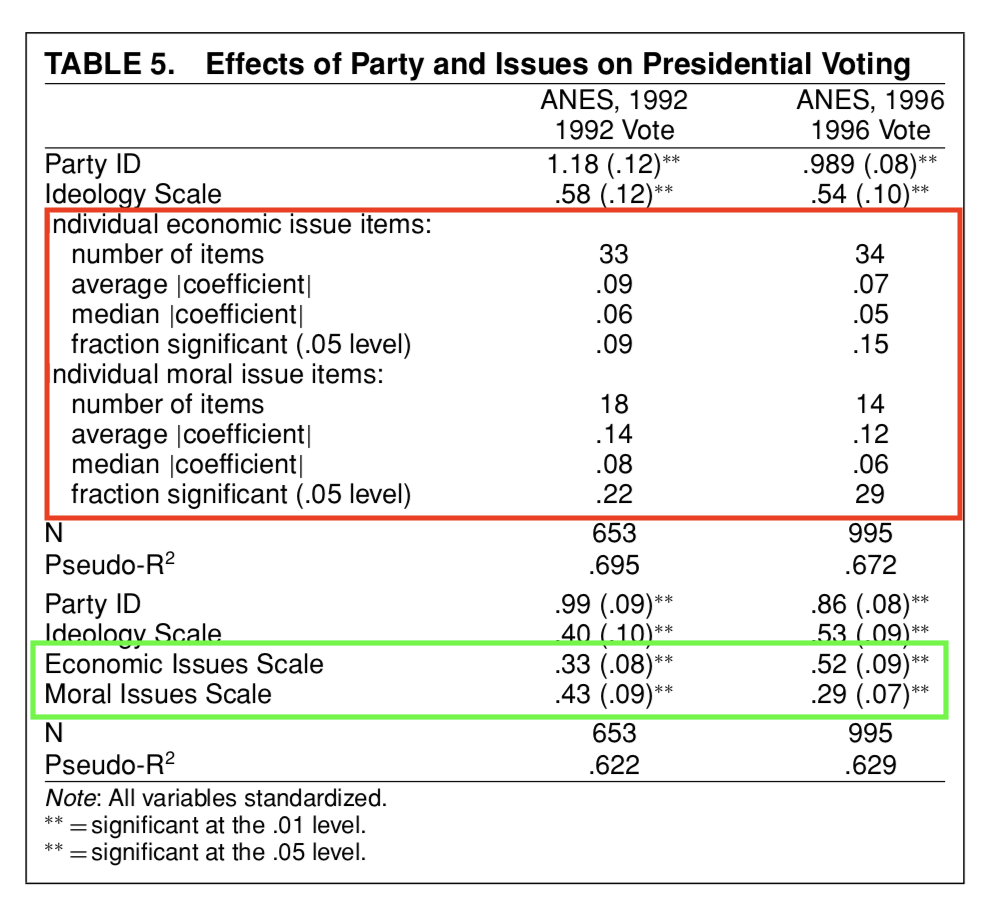
What’s are the conclusions
Democracy is saved?
It’s the measures not the public that’s the problem
Use multiple measures and scale them together to study the concepts we’re interested in
The importance of political sophistication may be overstated
Freeder et al. (2019)
What’s the research question
- Is the lack of ideological constraint really just a function of measurement error, or is it a product of citizens’ ignorance of “what goes with what”
What’s the theoretical framework
- Measurement error critiques of Converse like Ansolabehere et al. can’t distinguish between error due to:
- The vagaries of the question (classical measurement error)
- The vagaries of person (lack of knowledge)
- The vagaries of survey response (more on this later)
- Averaging reduces error from all of these sources
What’s the theoretical framework
- Knowledge of what goes with what (WGWW) measured by awareness of which party is more liberal or conservative explains lack of constraint, even after accounting for measurement error
What’s the empirical design
Panel data with multiple issue items, measures of general knowledge/sophistication, and specific measures of WGWW proxied by candidate and party placements
Correlations and scale properties
Sub-group analysis
Regression analysis
Simulations
What are the results
More items reduces measurement error
Constraint doesn’t vary with general knowledge, but does vary with WGWW
True of scales and individual items
WGWW predicts attitude stability
But only for people who agree with their party’s positions
More items won’t fix the problem
More items reduces measurement error

Constraint doesn’t vary with general knowledge, but does vary with WGWW
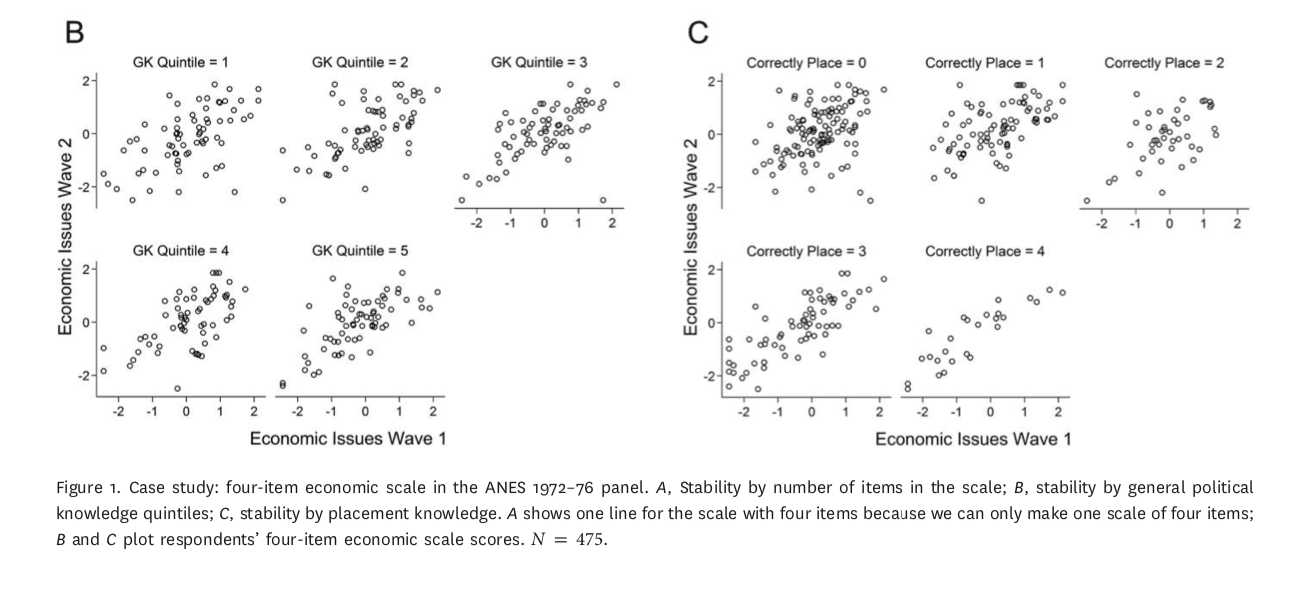
True of scales and individual items

WGWW predicts attitude stability

But only for people who agree with their party’s positions

More items won’t fix the problem
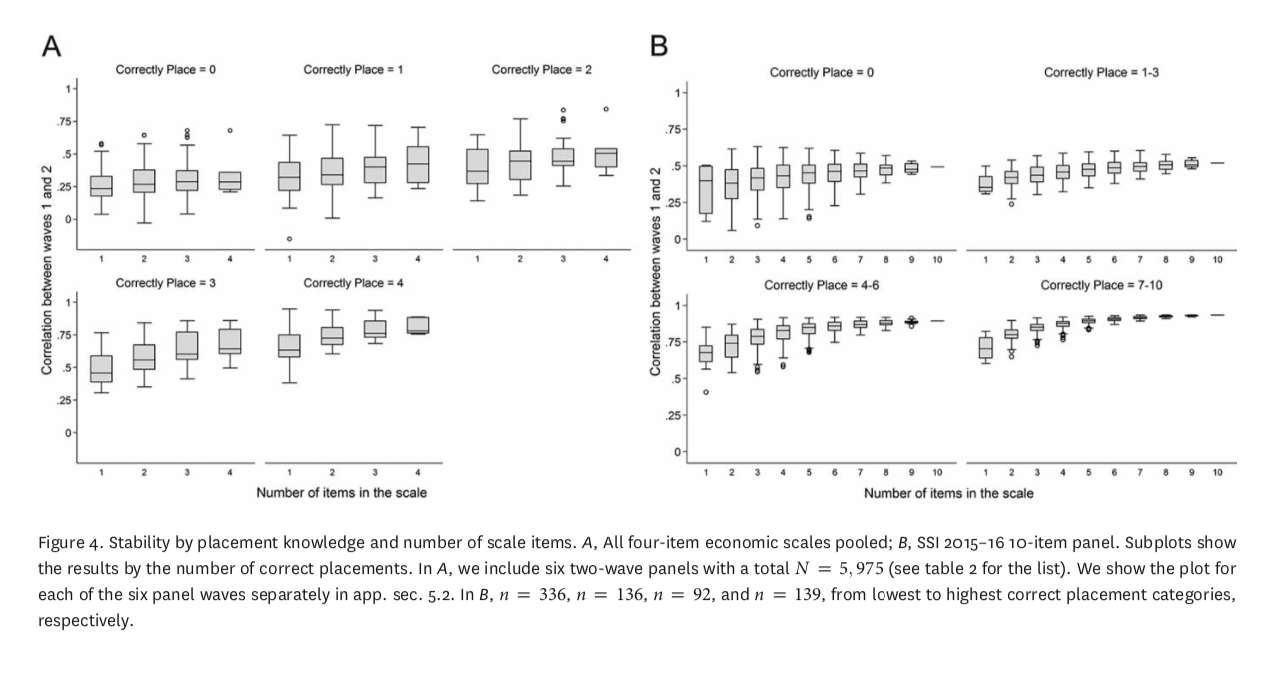
What are the conclusions
Correcting for measurement error alone won’t save democracy
Multiple items are still useful
- But what does the first principal component of a multi item scale really mean?
Where does knowledge of what goes with what come from?
- Are parties the only source of constraint?
References

POLS 1140
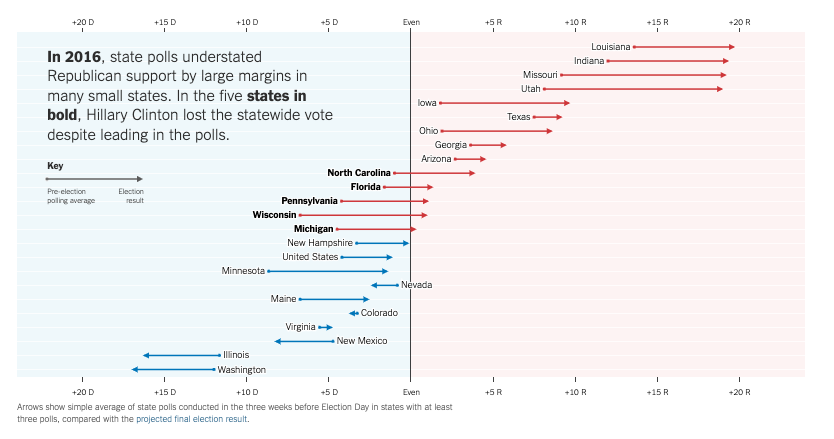

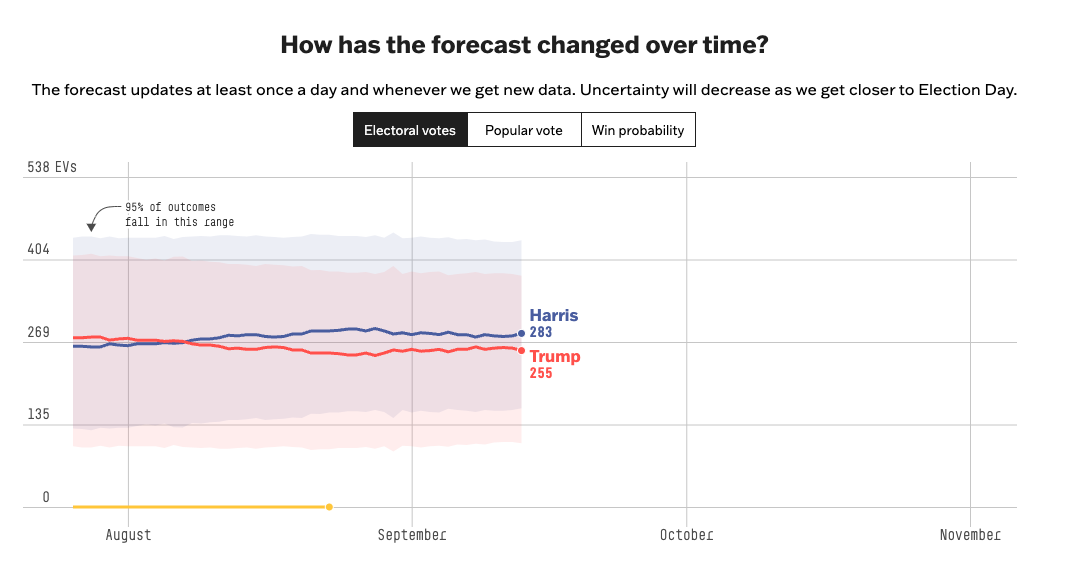

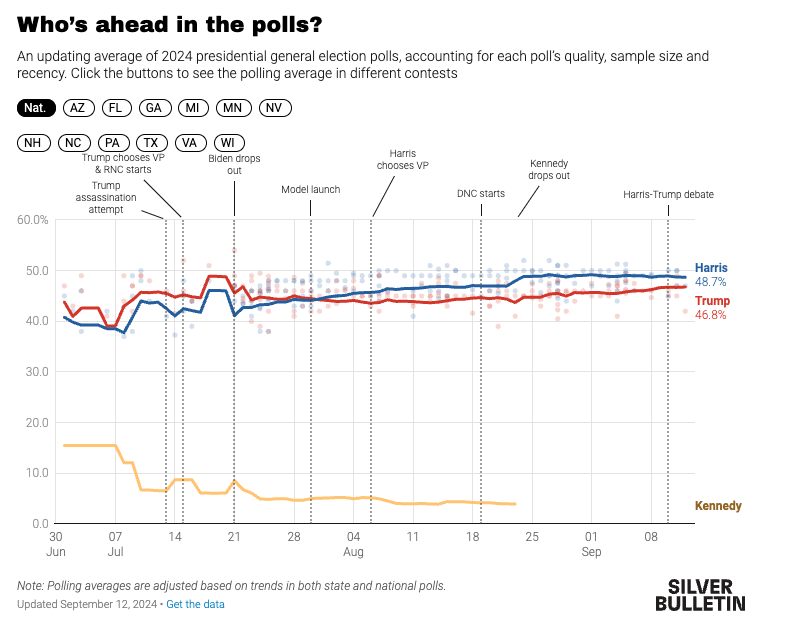

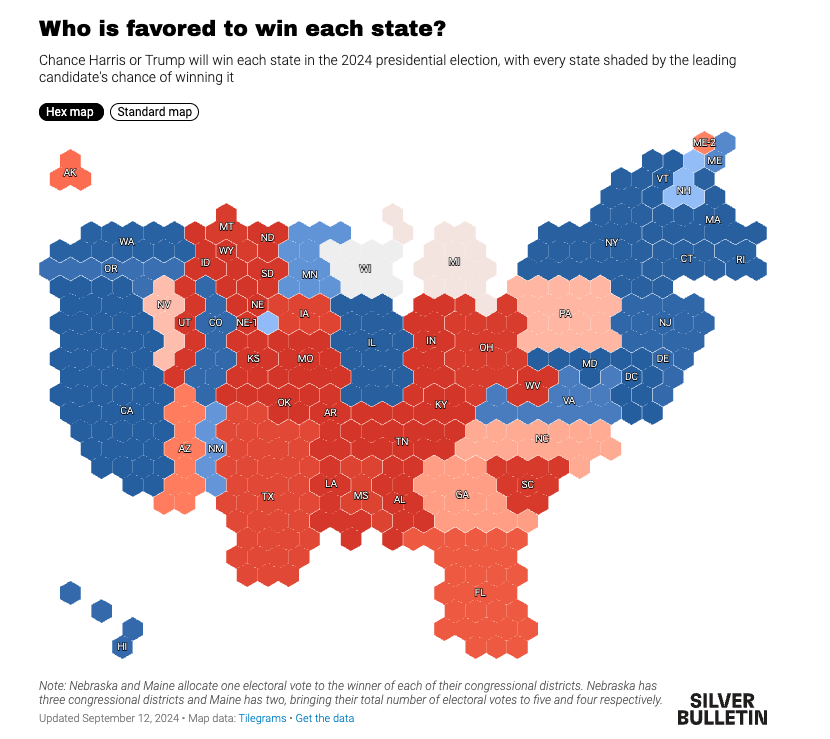
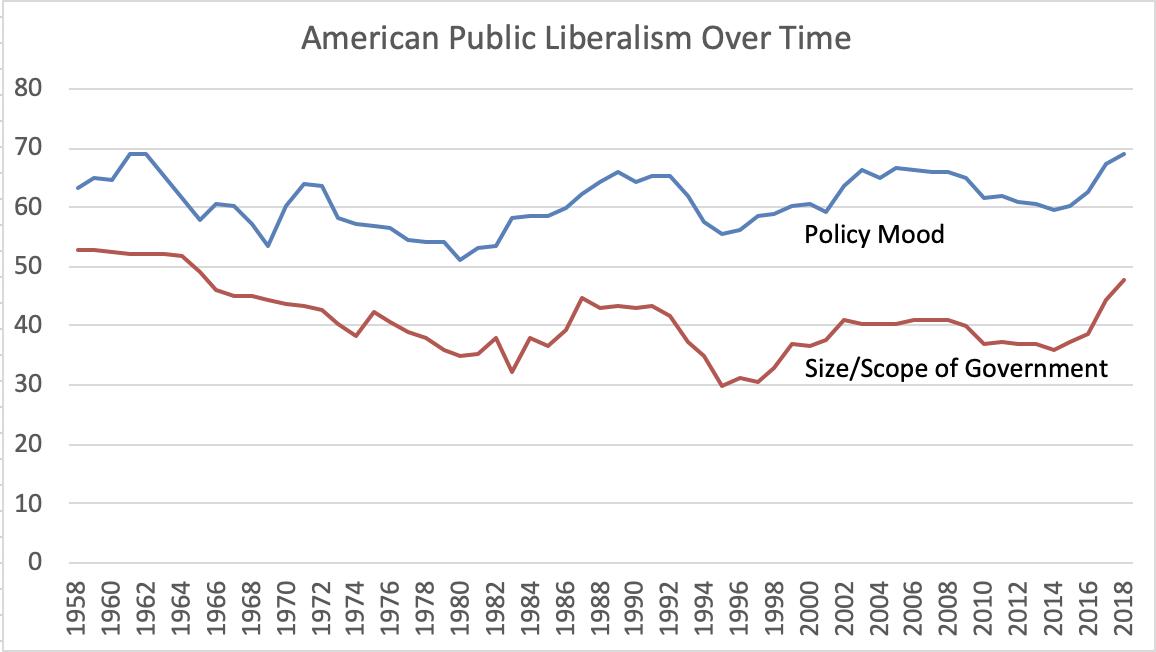
Social Groupings as central objects in belief systems